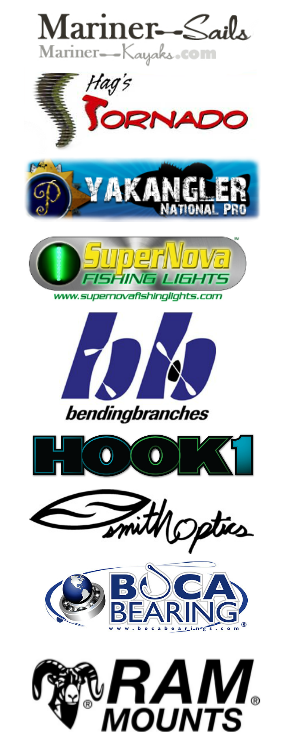by ChrisCoufal
Using Google Earth prior to a fishing trip has many advantages. It allows you to quickly scout the lake and look for what I call "POI" or also known as "Points Of Interest". Before I ever head to a new body of water, I always spend an evening scouting the lake in Google Earth and marking waypoints to check out once I'm on the water. GE also has a historic timeline that allows you to find great structure/cover when the water was low that might not be seen once the water is back to regular level. Once you set your waypoints in GE, you will need to save them, convert them and then upload them into your fish finder so that you have them once you are on the water. Here is one way to go about doing this and then using the files in my Lowrance HDS10 to have a super productive trip:
When you have GE open, you will need to select the files you want to convert. I prefer to save them by lake and load them specifically for the lake I am headed to. The reason I do this is because some units will not hold over 5000 waypoints and some units do not allow different waypoints to contain the same file name. I also label my waypoints by what they are so that I can quickly tell while on the water. For example, rocks will be labeled RCK1, RCK2.....or a bridge might be BRG1 and BRG2. By saving the lakes on GE by specific folders, it allows me to be very detailed with my waypoint management.
Click the lake folder you want to convert. In this case we will use Lake Georgetown. When I check the folder, it will check all of the waypoints inside of it. Everything that is checked will be converted. In this example you can see all of the waypoints labeled as FA. These are fish attractors placed out by TPWD. Right click the folder and click "save as". Change the file type to .KML
Secondly you will need to go to http://www.gpsbabel.org/download.html#downloading and download the most current version of GPSBabel. This is a free program.
After you install the program, open it up and your screen should look like this image below. The first thing you want to do under the "INPUT" section is to change the format to "Google Earth Keyhole Markup Language". This is also known as .KML and is the file type you saved your waypoints as.
Next you will want to locate the .kml file you saved. Click "file names" and find the file. Mine is in a folder and labeled as Georgetown.kml. Click it so that it adds the location to the GPSBabel program.
After this, you will move to the "OUTPUT" section and change the format to the new format you are trying to use in your fish finder. Lowrance uses .USR files.
Next click "file name" in the OUTPUT section and locate the folder you want to save it to. Name the file and click save. You can see that I again named mine "Georgetown". make sure that the file type is the proper one you are trying to convert it to. In this example we are converting to a Lowrance file or a .usr
Next you click "APPLY"
That's it.......you are all done. You can see both the GE file and the Lowrance file in my folder. Save the Lowrance file to your SD card and upload it to your unit. You can import the waypoints and be ready to hit all of the areas you found prior to ever launching your boat.
Don't forget that time on the water and good waypoint management are both invaluable. Time on the water and time studying the maps are huge advantages that not everyone has access to. When you start building your waypoint collection, don't forget to save them multiple times in multiple places. If you ever have equipment failure, you do not want to lose the weeks, months, years you have invested into locating those waypoints.
I hope this helps you guys.
When you have GE open, you will need to select the files you want to convert. I prefer to save them by lake and load them specifically for the lake I am headed to. The reason I do this is because some units will not hold over 5000 waypoints and some units do not allow different waypoints to contain the same file name. I also label my waypoints by what they are so that I can quickly tell while on the water. For example, rocks will be labeled RCK1, RCK2.....or a bridge might be BRG1 and BRG2. By saving the lakes on GE by specific folders, it allows me to be very detailed with my waypoint management.
Click the lake folder you want to convert. In this case we will use Lake Georgetown. When I check the folder, it will check all of the waypoints inside of it. Everything that is checked will be converted. In this example you can see all of the waypoints labeled as FA. These are fish attractors placed out by TPWD. Right click the folder and click "save as". Change the file type to .KML
Secondly you will need to go to http://www.gpsbabel.org/download.html#downloading and download the most current version of GPSBabel. This is a free program.
After you install the program, open it up and your screen should look like this image below. The first thing you want to do under the "INPUT" section is to change the format to "Google Earth Keyhole Markup Language". This is also known as .KML and is the file type you saved your waypoints as.
Next you will want to locate the .kml file you saved. Click "file names" and find the file. Mine is in a folder and labeled as Georgetown.kml. Click it so that it adds the location to the GPSBabel program.
After this, you will move to the "OUTPUT" section and change the format to the new format you are trying to use in your fish finder. Lowrance uses .USR files.
Next click "file name" in the OUTPUT section and locate the folder you want to save it to. Name the file and click save. You can see that I again named mine "Georgetown". make sure that the file type is the proper one you are trying to convert it to. In this example we are converting to a Lowrance file or a .usr
Next you click "APPLY"
That's it.......you are all done. You can see both the GE file and the Lowrance file in my folder. Save the Lowrance file to your SD card and upload it to your unit. You can import the waypoints and be ready to hit all of the areas you found prior to ever launching your boat.
Don't forget that time on the water and good waypoint management are both invaluable. Time on the water and time studying the maps are huge advantages that not everyone has access to. When you start building your waypoint collection, don't forget to save them multiple times in multiple places. If you ever have equipment failure, you do not want to lose the weeks, months, years you have invested into locating those waypoints.
I hope this helps you guys.
Email ThisBlogThis!Share to TwitterShare to Facebook














0 comments:
Post a Comment